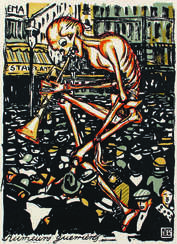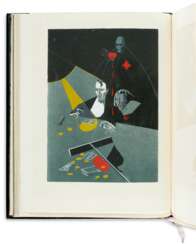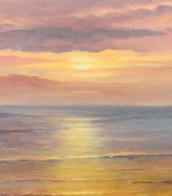macabre

Pierre Mac Orlan, real name Pierre Dumarchey, is a French writer, poet, screenwriter, playwright, artist and journalist.
Pierre Dumarchey spent his youth leading a bohemian lifestyle, but by the age of 20 he had already published several collections of short stories with his own illustrations. He socialized with many contemporary writers and artists, played the accordion, and many of his songs were quite popular in cabarets. In World War
I in 1916, Pierre Dumarchey was wounded, after which he worked as a war correspondent. In the late 1920s, he became an influential critic of film and photography. And later became a famous writer under the pseudonym Pierre Mac-Orlan. Based on his most famous novel Quai des Brumes ("Port of Shadows"), French director Marcel Carné made a movie of the same name in 1938.
In addition to his numerous novels, Mac-Orlan published under various pseudonyms in erotic magazines. Pierre Mac-Orlan was a very prolific writer: in 1969-1971, a collection of his works in 24 volumes was published, which, however, did not include his many erotic works.



Edgar Allan Poe was an American writer and poet, editor and critic who created a form of classical detective fiction in an atmosphere of mystery and horror.
In prose, Allan Poe wrote mostly short stories. His novella The Murders in the Rue Morgue (1841) initiated the modern detective story, and his poem The Raven (1845) is among the most famous in American literature. Romanticism of the first third of the 19th century was shrouded in a fog of Satanism and the occult, which obviously influenced the work of Poe, whose personality was subtle, dualistic, and multifaceted.
Most of Poe's best works are permeated with horror and sorrow, but in life the poet was a pleasant conversationalist with a great sense of humor and a talented orator. All this, coupled with the genius of the writer-narrator provided him with a prominent place among the world-famous writers. Edgar Allan Poe revolutionized the horror genre. He was one of the first to bring deep, visceral, psychological horror into literature. In his stories, the true monster often turned out to be the capacity for evil that lurks within every human being.






Hans Holbein the Younger was a German-Swiss painter and printmaker who worked in a Northern Renaissance style, and is considered one of the greatest portraitists of the 16th century. He also produced religious art, satire, and Reformation propaganda, and he made a significant contribution to the history of book design. He is called "the Younger" to distinguish him from his father Hans Holbein the Elder, an accomplished painter of the Late Gothic school.




![[DANSE MACABRE] - RUSTING, Salomon van (1652-c 1713) Het Sch...](/assets/image/picture_1080050/30406/6xi5acbmhqzowzmxnzewkgag13arhw3dnwxceofawnhuoonvbeobke12c83qgow91602251697jpg__fix_374_244.jpeg)
![[DANSE MACABRE] - RUSTING, Salomon van (1652-c 1713) Het Sch...](https://veryimportantlot.com/assets/image/picture_1080050/30406/6xi5acbmhqzowzmxnzewkgag13arhw3dnwxceofawnhuoonvbeobke12c83qgow91602251697jpg__fix_374_244.jpeg)
















































![[HOLBEIN, Hans dit le Jeune (1497-1543)] ; [LÜTZELBURGER, Hans ( ? - 1526)] ; [CORROZET, Gilles (1510-1568)] ; [VAUZELLES, Jean de ( ? - v. 1563)]](/assets/image/picture_3807156/59396/408c4823fd9b5ec1f48bdc4eef452c581710234000jpg__fix_374_244.jpeg)
![[HOLBEIN, Hans dit le Jeune (1497-1543)] ; [LÜTZELBURGER, Hans ( ? - 1526)] ; [CORROZET, Gilles (1510-1568)] ; [VAUZELLES, Jean de ( ? - v. 1563)]](https://veryimportantlot.com/assets/image/picture_3807156/59396/408c4823fd9b5ec1f48bdc4eef452c581710234000jpg__fix_374_244.jpeg)












